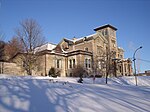McGill University Faculty of Law

The Faculty of Law is one of the professional graduate schools of McGill University in Montreal, Quebec, Canada. It is the oldest law school in Canada, and continually ranks among the best law schools in the world. The faculty is known for its holistic approach though highly selective and competitive process for admission. Only 180 candidates are admitted for any given academic year and the acceptance rate is generally at 11%. McGill Faculty of Law has consistently ranked as the top law school for civil law, a top law school for common law, the most number of Supreme Court clerkships of any law school in Canada, and consistently outranks Europe, Asia, and Latin America's top civil law schools.Notable alumni include Prime Ministers John Abbott and Sir Wilfrid Laurier, thirteen Justices of the Supreme Court (Including the most recent appointments, Mahmud Jamal and Nicholas Kasirer), as well as numerous Members of Parliament. Three members of the current Cabinet of Canada are graduates of the Faculty: Catherine McKenna, David Lametti, and Marc Miller.
Excerpt from the Wikipedia article McGill University Faculty of Law (License: CC BY-SA 3.0, Authors, Images).McGill University Faculty of Law
Avenue Docteur Penfield, Montreal Ville-Marie
Geographical coordinates (GPS) Address Nearby Places Show on map
Geographical coordinates (GPS)
| Latitude | Longitude |
|---|---|
| N 45.50321 ° | E -73.58058 ° |
Address
McGill University
Avenue Docteur Penfield
H3G 1Y5 Montreal, Ville-Marie
Quebec, Canada
Open on Google Maps









